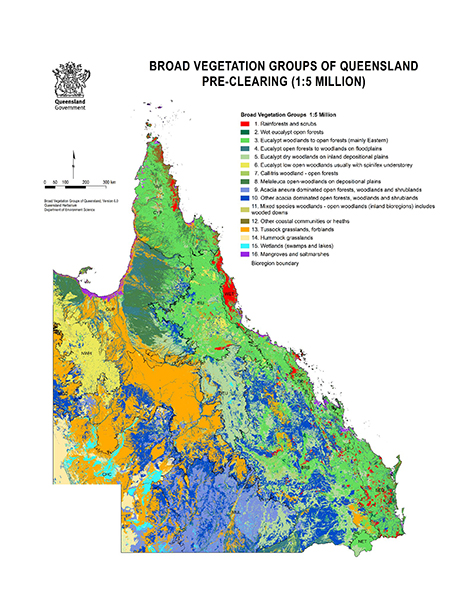Broad vegetation groups
Broad vegetation groups (BVGs) are a higher-level grouping of vegetation communities. Queensland encompasses a wide variety of landscapes across temperate, wet and dry tropics and semi-arid to arid climatic zones. Broad vegetation groups provide an overview of vegetation communities across the state or a bioregion and allow comparison with other states.
Download:
- Summary statistics for broad vegetation group vegetation communities
- The Vegetation of Queensland: Descriptions of Broad Vegetation Groups (PDF, 31.1MB)
- (Recommended citation: Neldner, V.J., Niehus, R.E., Wilson, B.A., McDonald, W.J.F., Ford, A.J. and Accad, A. (2023). The Vegetation of Queensland. Descriptions of Broad Vegetation Groups. Version 6.0. Queensland Herbarium and Biodiversity Science, Department of Environment, Science and Innovation.)
Customised maps coloured by broad vegetation group
Request a map of biodiversity status or broad vegetation group. These maps are not statutory.
Maps can be requested using property details or central coordinates and will be emailed to you as a PDF file.

Broad vegetation groups of Queensland (view larger version)
Broad vegetation groups (BVGs) are a higher-level grouping of vegetation communities. Queensland encompasses a wide variety of landscapes across temperate, wet and dry tropics and semi-arid to arid climatic zones. Broad vegetation groups provide an overview of vegetation communities across the state or a bioregion and allow comparison with other states.
The Queensland Herbarium amalgamates vegetation communities on an ecological basis to form BVGs. Some BVGs encompass vegetation types that are generally dominated by a single species, such as Melaleuca viridiflora, or a suite of species, such as Acacia spp. on residuals.
Other groups are dominated by a distinct structural formation (such as tussock and closed tussock grasslands) or by a combination of a structural formation and habitat (such as dry woodlands, primarily on coastal sandplains and dunes). Specialised habitats such as coral islands and intertidal areas form other groups.
There are 3 levels of broad vegetation groups, which reflect the approximate scale at which they are designed to be used:
- 1:5,000,000 (national)
- 1:2,000,000 (state)
- 1:1,000,000 (regional).
The pre-clearing and remnant BVGs of Queensland spatial dataset, derived from the regional ecosystem mapping, includes the dominant broad vegetation groups as DBVG1M, DBVG2M, and DBVG5M. These data are available through the Queensland Government data portal or the Queensland Globe—Biota.